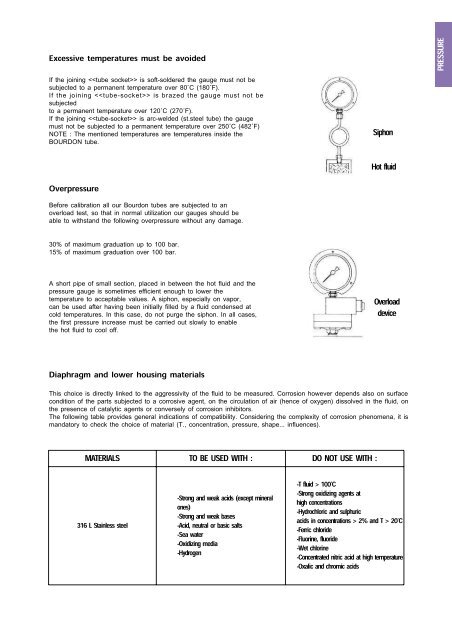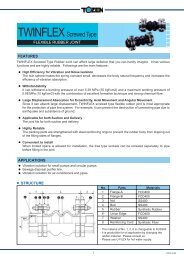PRESSURE GAUGE PRESSURE GAUGE
PRESSURE GAUGE PRESSURE GAUGE
PRESSURE GAUGE PRESSURE GAUGE
You also want an ePaper? Increase the reach of your titles
YUMPU automatically turns print PDFs into web optimized ePapers that Google loves.
Excessive temperatures must be avoided<br />
If the joining is soft-soldered the gauge must not be<br />
subjected to a permanent temperature over 80˚C (180 ˚F).<br />
If the joining is brazed the gauge must not be<br />
subjected<br />
to a permanent temperature over 120˚C (270˚F).<br />
If the joining is arc-welded (st.steel tube) the gauge<br />
must not be subjected to a permanent temperature over 250˚C (482˚F)<br />
NOTE : The mentioned temperatures are temperatures inside the<br />
BOURDON tube.<br />
Overpressure<br />
Before calibration all our Bourdon tubes are subjected to an<br />
overload test, so that in normal utilization our gauges should be<br />
able to withstand the following overpressure without any damage.<br />
30% of maximum graduation up to 100 bar.<br />
15% of maximum graduation over 100 bar.<br />
A short pipe of small section, placed in between the hot fluid and the<br />
pressure gauge is sometimes efficient enough to lower the<br />
temperature to acceptable values. A siphon, especially on vapor,<br />
can be used after having been initially filled by a fluid condensed at<br />
cold temperatures. In this case, do not purge the siphon. In all cases,<br />
the first pressure increase must be carried out slowly to enable<br />
the hot fluid to cool off.<br />
Diaphragm and lower housing materials<br />
Siphon<br />
Hot fluid<br />
Overload<br />
device<br />
This choice is directly linked to the aggressivity of the fluid to be measured. Corrosion however depends also on surface<br />
condition of the parts subjected to a corrosive agent, on the circulation of air (hence of oxygen) dissolved in the fluid, on<br />
the presence of catalytic agents or conversely of corrosion inhibitors.<br />
The following table provides general indications of compatibility. Considering the complexity of corrosion phenomena, it is<br />
mandatory to check the choice of material (T., concentration, pressure, shape... influences).<br />
MATERIALS<br />
316 L Stainless steel<br />
TO BE USED WITH :<br />
-Strong<br />
ones)<br />
and weak acids (except mineral<br />
-Strong<br />
-Acid, neutral<br />
and weak<br />
or basic<br />
bases<br />
-Sea water<br />
salts<br />
-Oxidizing<br />
-Hydrogen<br />
media<br />
DO NOT USE WITH :<br />
-T<br />
-Strong<br />
fluid ><br />
oxidizing<br />
100˚C<br />
high concentrations<br />
agents at<br />
-Hydrochloric<br />
acids in concentrations<br />
and sulphuric<br />
-Ferric chloride<br />
> 2% and T > 20˚C<br />
-Fluorine,<br />
-Wet chlorine<br />
fluoride<br />
-Concentrated<br />
-Oxalic and chromic<br />
nitric acid<br />
acids<br />
at high temperature<br />
<strong>PRESSURE</strong>



